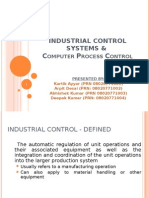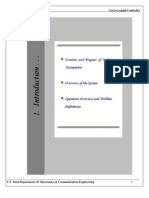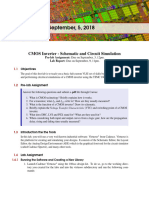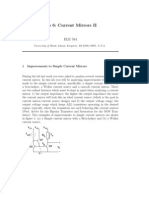System Dynamics and Control: Unggul Wasiwitono
Uploaded by
Heru TheerteSystem Dynamics and Control: Unggul Wasiwitono
Uploaded by
Heru TheerteSystem Dynamics and Control
Introduction
Unggul Wasiwitono
Mechanical Engineering Department
Faculty of Industrial Technology and Systems Engineering
Introduction A History of Control Systems System Configurations Analysis and Design Objectives The Design Process Computer-Aided Design
Introduction
[System Dynamics and Control] - Introduction
2 / 22
Introduction A History of Control Systems System Configurations Analysis and Design Objectives The Design Process Computer-Aided Design
Learning Objectives
The student will be able to:
1 Define a control system and describe some applications
2 Describe historical developments leading to modern-day control theory
3 Describe the basic features and configurations of control systems
4 Describe control systems analysis and design objectives Describe a control system’s design
process
5 Describe the benefit of studying control systems
[System Dynamics and Control] - Introduction
3 / 22
Introduction A History of Control Systems System Configurations Analysis and Design Objectives The Design Process Computer-Aided Design
Control System Definition
A control system consists of subsystems and processes (or plants) assembled for the
purpose of obtaining a desired output with desired performance, given a specified
input.
Input; stimulus Output; response
Control system
Desired response Actual response
Two major measures of performance are apparent:
1 the transient response
2 the steady-state error.
[System Dynamics and Control] - Introduction
4 / 22
Introduction A History of Control Systems System Configurations Analysis and Design Objectives The Design Process Computer-Aided Design
Control System Definition
[System Dynamics and Control] - Introduction
5 / 22
Introduction A History of Control Systems System Configurations Analysis and Design Objectives The Design Process Computer-Aided Design
Advantages of Control Systems
We build control systems for four primary reasons:
1 Power amplificationn
2 Remote control
3 Convenience of input form
4 Compensation for disturbance
[System Dynamics and Control] - Introduction
6 / 22
Introduction A History of Control Systems System Configurations Analysis and Design Objectives The Design Process Computer-Aided Design
A History of Control Systems
[System Dynamics and Control] - Introduction
7 / 22
Introduction A History of Control Systems System Configurations Analysis and Design Objectives The Design Process Computer-Aided Design
History of Control Systems
Feedback control has a long history which began with the early desire of humans to
harness the materials and forces of nature to their advantage.
[System Dynamics and Control] - Introduction
8 / 22
Introduction A History of Control Systems System Configurations Analysis and Design Objectives The Design Process Computer-Aided Design
History of Control Systems
Feedback control has a long history which began with the early desire of humans to
harness the materials and forces of nature to their advantage.
1 Liquid-Level Control
1 The Greeks began engineering feedback systems around 300 B.C.
2 Steam Pressure and Temperature Controls
1 Regulation of steam pressure began around 1681 with Denis Papin’s invention of the safety valve.
3 Speed Control
1 In 1745, speed control was applied to a windmill by Edmund Lee.
2 James Watt invented the flyball speed governor to control the speed of steam engines.
4 Stability, Stabilization, and Steering
1 In 1868, James Clerk Maxwell published the stability criterion for a third-order system based on the
coefficients of the differential equation.
2 In 1874, Edward John Routh extend the stability criterion to fifth-order systems.
5 Twentieth-Century Developments
[System Dynamics and Control] - Introduction
8 / 22
Introduction A History of Control Systems System Configurations Analysis and Design Objectives The Design Process Computer-Aided Design
Motivation for Control Engineering
1 By the end of the twentieth century, control has become a ubiquitous (but largely unseen)
element of modern society.
[System Dynamics and Control] - Introduction
9 / 22
Introduction A History of Control Systems System Configurations Analysis and Design Objectives The Design Process Computer-Aided Design
Motivation for Control Engineering
1 By the end of the twentieth century, control has become a ubiquitous (but largely unseen)
element of modern society.
2 Virtually every system we come in contact with is underpinned by sophisticated control
systems. Examples range from
1 simple household products (temperature regulation in air-conditioners, thermostats in hot water
heaters etc.)
2 to more sophisticated systems such as the family car (which has hundreds of control loops)
3 to large scale systems (such as chemical plants, aircraft, and manufacturing processes).
[System Dynamics and Control] - Introduction
9 / 22
Introduction A History of Control Systems System Configurations Analysis and Design Objectives The Design Process Computer-Aided Design
Motivation for Control Engineering
1 By the end of the twentieth century, control has become a ubiquitous (but largely unseen)
element of modern society.
2 Virtually every system we come in contact with is underpinned by sophisticated control
systems. Examples range from
1 simple household products (temperature regulation in air-conditioners, thermostats in hot water
heaters etc.)
2 to more sophisticated systems such as the family car (which has hundreds of control loops)
3 to large scale systems (such as chemical plants, aircraft, and manufacturing processes).
3 Beyond these industrial examples, feedback regulatory mechanisms are central to the
operation of biological systems, communication networks, national economies, and even
human interactions.
[System Dynamics and Control] - Introduction
9 / 22
Introduction A History of Control Systems System Configurations Analysis and Design Objectives The Design Process Computer-Aided Design
Motivation for Control Engineering
Market Globalization Issues
To stay in business, manufacturing industries are necessarily placing increasing emphasis on
issues of quality and efficiency.
This focuses attention on the development of improved control systems so that processes
operate in the best possible way.
Improved control is a key enabling technology underpinning:
enhanced product quality
waste minimization
environmental protection
greater throughput for a given installed capacity
deferring costly plant upgrades, and
higher safety margins.
Link
[System Dynamics and Control] - Introduction
10 / 22
Introduction A History of Control Systems System Configurations Analysis and Design Objectives The Design Process Computer-Aided Design
System Configurations
[System Dynamics and Control] - Introduction
11 / 22
Introduction A History of Control Systems System Configurations Analysis and Design Objectives The Design Process Computer-Aided Design
System Configurations
Two major configurations of control systems: open loop and closed loop
[System Dynamics and Control] - Introduction
12 / 22
Introduction A History of Control Systems System Configurations Analysis and Design Objectives The Design Process Computer-Aided Design
System Configurations
Open-Loop Systems
1 it cannot compensate for any disturbances
2 simpler and less expensive than closed-loop systems.
[System Dynamics and Control] - Introduction
13 / 22
Introduction A History of Control Systems System Configurations Analysis and Design Objectives The Design Process Computer-Aided Design
System Configurations
Open-Loop Systems
1 it cannot compensate for any disturbances
2 simpler and less expensive than closed-loop systems.
Closed-Loop Systems
1 compensates for disturbances
2 less sensitive to noise, disturbances, and changes in the environment.
3 more complex and expensive than open-loop systems.
[System Dynamics and Control] - Introduction
13 / 22
Introduction A History of Control Systems System Configurations Analysis and Design Objectives The Design Process Computer-Aided Design
Example
[System Dynamics and Control] - Introduction
14 / 22
Introduction A History of Control Systems System Configurations Analysis and Design Objectives The Design Process Computer-Aided Design
Analysis and Design Objectives
[System Dynamics and Control] - Introduction
15 / 22
Introduction A History of Control Systems System Configurations Analysis and Design Objectives The Design Process Computer-Aided Design
Analysis and Design Objectives
To achieve goo control there are typical goals:
1 Stability: The system must be stable at all times. This is an absolute requirement.
2 Tracking: The system output must track the command reference signal as closely as possible
1 Transient response
2 Steady-State response
3 Disturbance rejection: The system ouput must be as insensitive as possible to disturbance
inputs.
4 Robustness: The aforementioned goals must be met even if the model used in the design is
not completely accurate or if the dynamics of the physical system change over time.
[System Dynamics and Control] - Introduction
16 / 22
Introduction A History of Control Systems System Configurations Analysis and Design Objectives The Design Process Computer-Aided Design
The Design Process
[System Dynamics and Control] - Introduction
17 / 22
Introduction A History of Control Systems System Configurations Analysis and Design Objectives The Design Process Computer-Aided Design
The Design Process
[System Dynamics and Control] - Introduction
18 / 22
Introduction A History of Control Systems System Configurations Analysis and Design Objectives The Design Process Computer-Aided Design
Computer-Aided Design
[System Dynamics and Control] - Introduction
19 / 22
Introduction A History of Control Systems System Configurations Analysis and Design Objectives The Design Process Computer-Aided Design
The Matlab Environment
[System Dynamics and Control] - Introduction
20 / 22
Introduction A History of Control Systems System Configurations Analysis and Design Objectives The Design Process Computer-Aided Design
Getting Started with MATLAB and Simulink
Getting Started with MATLAB Link
Getting Started with Simulink Link
How to install MATLAB Academic version Link
[System Dynamics and Control] - Introduction
21 / 22
Question ?
You might also like
- Process Dynamics & Control: Muhammad Rashed JavedNo ratings yetProcess Dynamics & Control: Muhammad Rashed Javed32 pages
- Linear Control System Design-Introduction02No ratings yetLinear Control System Design-Introduction0243 pages
- 1.introduction To Control System EngineeringNo ratings yet1.introduction To Control System Engineering40 pages
- Control Systems: Lect. 1 Introduction Basil HamedNo ratings yetControl Systems: Lect. 1 Introduction Basil Hamed30 pages
- J96 - The Real-Time Supervisory Control of An Experimental Manufacturing CellNo ratings yetJ96 - The Real-Time Supervisory Control of An Experimental Manufacturing Cell14 pages
- Qualitative_modelling_and_control_of_industrial_pr (3)No ratings yetQualitative_modelling_and_control_of_industrial_pr (3)6 pages
- Systems Engineering Standards A Summary PDFNo ratings yetSystems Engineering Standards A Summary PDF9 pages
- Hệ thống Điều khiển tự động: (Automatic control systems)No ratings yetHệ thống Điều khiển tự động: (Automatic control systems)235 pages
- Final Report On Cut To Length Controller Using P89LPC932No ratings yetFinal Report On Cut To Length Controller Using P89LPC932135 pages
- Topic#1 Introduction To Control SystemsNo ratings yetTopic#1 Introduction To Control Systems55 pages
- Lecture 3, Fundamentals of Systems (عرض تقديمي)No ratings yetLecture 3, Fundamentals of Systems (عرض تقديمي)12 pages
- Engineering Manufacturing Control Systems Using PROSA and Delegate MASNo ratings yetEngineering Manufacturing Control Systems Using PROSA and Delegate MAS29 pages
- System of Systems Engineering: Innovations for the 21st CenturyFrom EverandSystem of Systems Engineering: Innovations for the 21st CenturyNo ratings yet
- Embedded Systems Programming with C++: Real-World TechniquesFrom EverandEmbedded Systems Programming with C++: Real-World TechniquesNo ratings yet
- Fortnite Collison Decision C2799a624eadNo ratings yetFortnite Collison Decision C2799a624ead13 pages
- The Effective Marketing Strategies in Selling Wrapped Dessert of Selected Grade 11 Abm Students in Arellano UniversityNo ratings yetThe Effective Marketing Strategies in Selling Wrapped Dessert of Selected Grade 11 Abm Students in Arellano University9 pages
- Design for Social Innovation Ezio ManziniNo ratings yetDesign for Social Innovation Ezio Manzini10 pages
- 4100 Programming Pseudo Point DefinitionsNo ratings yet4100 Programming Pseudo Point Definitions42 pages
- A Conversation With Jose Alfredo Ramirez PDFNo ratings yetA Conversation With Jose Alfredo Ramirez PDF6 pages
- Licensure Examination For Architects (LEA) 2011 Syllabus For The Subject of ARCHITECTURAL DESIGN andNo ratings yetLicensure Examination For Architects (LEA) 2011 Syllabus For The Subject of ARCHITECTURAL DESIGN and6 pages
- Water Tank Analysis Using STAAD PRO: Mainak GhosalNo ratings yetWater Tank Analysis Using STAAD PRO: Mainak Ghosal9 pages
- TO Rapid Prototyping (RP) : Prepared By: Dr. Chirag R. SanghaniNo ratings yetTO Rapid Prototyping (RP) : Prepared By: Dr. Chirag R. Sanghani11 pages
- Steam-Powered Books - Chip by Kylie HowarthNo ratings yetSteam-Powered Books - Chip by Kylie Howarth2 pages
- A Contractor's Guide To Delegated Design and Cold-Formed Metal Shop Drawing - 2019-03-01 - Walls & CeilingsNo ratings yetA Contractor's Guide To Delegated Design and Cold-Formed Metal Shop Drawing - 2019-03-01 - Walls & Ceilings5 pages
- Bridging The Gap: Comprehensive Professional Approach Ar. Prachi BafnaNo ratings yetBridging The Gap: Comprehensive Professional Approach Ar. Prachi Bafna5 pages
- Classroom Inventory Form. EOSY 2022-2023No ratings yetClassroom Inventory Form. EOSY 2022-20234 pages
- E4E - A - ES - CO - DT - GAP - CO8 - Reparto Costes Comunes - WAVE To Be v1.0No ratings yetE4E - A - ES - CO - DT - GAP - CO8 - Reparto Costes Comunes - WAVE To Be v1.034 pages
- Data Driven System Engineering: Automotive ECU DevelopmentFrom EverandData Driven System Engineering: Automotive ECU Development
- J96 - The Real-Time Supervisory Control of An Experimental Manufacturing CellJ96 - The Real-Time Supervisory Control of An Experimental Manufacturing Cell
- Qualitative_modelling_and_control_of_industrial_pr (3)Qualitative_modelling_and_control_of_industrial_pr (3)
- Hệ thống Điều khiển tự động: (Automatic control systems)Hệ thống Điều khiển tự động: (Automatic control systems)
- Final Report On Cut To Length Controller Using P89LPC932Final Report On Cut To Length Controller Using P89LPC932
- Engineering Manufacturing Control Systems Using PROSA and Delegate MASEngineering Manufacturing Control Systems Using PROSA and Delegate MAS
- System of Systems Engineering: Innovations for the 21st CenturyFrom EverandSystem of Systems Engineering: Innovations for the 21st Century
- Handbook of Systems Engineering and ManagementFrom EverandHandbook of Systems Engineering and Management
- Embedded Systems Programming with C++: Real-World TechniquesFrom EverandEmbedded Systems Programming with C++: Real-World Techniques
- System Health Management: with Aerospace ApplicationsFrom EverandSystem Health Management: with Aerospace Applications
- The Effective Marketing Strategies in Selling Wrapped Dessert of Selected Grade 11 Abm Students in Arellano UniversityThe Effective Marketing Strategies in Selling Wrapped Dessert of Selected Grade 11 Abm Students in Arellano University
- Licensure Examination For Architects (LEA) 2011 Syllabus For The Subject of ARCHITECTURAL DESIGN andLicensure Examination For Architects (LEA) 2011 Syllabus For The Subject of ARCHITECTURAL DESIGN and
- Water Tank Analysis Using STAAD PRO: Mainak GhosalWater Tank Analysis Using STAAD PRO: Mainak Ghosal
- TO Rapid Prototyping (RP) : Prepared By: Dr. Chirag R. SanghaniTO Rapid Prototyping (RP) : Prepared By: Dr. Chirag R. Sanghani
- A Contractor's Guide To Delegated Design and Cold-Formed Metal Shop Drawing - 2019-03-01 - Walls & CeilingsA Contractor's Guide To Delegated Design and Cold-Formed Metal Shop Drawing - 2019-03-01 - Walls & Ceilings
- Bridging The Gap: Comprehensive Professional Approach Ar. Prachi BafnaBridging The Gap: Comprehensive Professional Approach Ar. Prachi Bafna
- E4E - A - ES - CO - DT - GAP - CO8 - Reparto Costes Comunes - WAVE To Be v1.0E4E - A - ES - CO - DT - GAP - CO8 - Reparto Costes Comunes - WAVE To Be v1.0

























































































